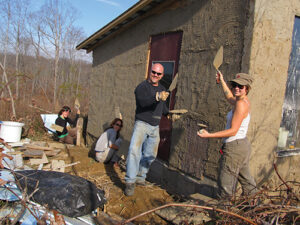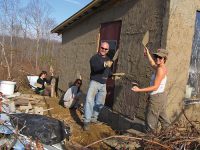 Excerpted from the Summer 2018 edition of Communities, “Eco-Building”—full issue available for download (by voluntary donation) here.
Excerpted from the Summer 2018 edition of Communities, “Eco-Building”—full issue available for download (by voluntary donation) here.
Humans modify our environment more than any other animals. We want to, we have to, protect ourselves from the elements. Is it possible for us to do so while respecting the sacred creation? The answer to that question cannot be summarized in a simple list of commandments, but the complexity of the answers only underscores the importance of our mindfulness.
I have lived in community all of my life. I have built conventional buildings, super-insulated buildings, and a variety of renewable energy systems. I have also organized some successful environmental campaigns. Green building could be our salvation or hasten our destruction, depending on what we pursue and how.
When I teach green building workshops, I talk to the participants about three levels of planning to consider, each of more importance by an order of magnitude than the one below. The most important level is context—what are you building, where, who’s using it, and for what purpose? The single family house on a mountaintop may have some appeal, but if you are driving an hour to work, another hour to pick up the kids and go shopping, and coming home to shovel firewood into the stove, you cannot add any “environmental” technology onto that situation to make it sustainable. Poor context means isolated. Good context means building the right thing in the right place. Though Americans have a near obsession with their own independence, by far the most important environmental “technology” ever developed is cooperative use—in a word, community. Community is THE technology that makes renewable energy viable.
The second order of magnitude is conservation and insulation. It is always cheaper to save energy with good insulation and conservationist design than to generate energy. Make no mistake, current incentives to put up grid-tie solar and other “renewable” energy sources on American homes instead of focusing on insulation and smart context have everything to do with politics and nothing to do with environmental protection.
Renewable energy sources are the third level of design consideration. Renewable energy when added onto conventional American buildings is a feeble supplement to fossil energy sources. Once one has considered appropriate context and developed wise conservationist design, then renewable energy becomes a powerful, liberating energy source that can allow us to live sustainably, and support communities that empower our democracy from the ground up.
Want to build green? Here’s your checklist (and there is a resource section at the end with links to material sources):
1) Don’t do it alone, or with just your spouse. Find a group to work with or live with. The more you can share, the lower your footprint will be. If you live in a tropical climate, the tiny houses are fine. If you live in a climate that gets cold, then free-standing housing will always have a devastating footprint compared to shared spaces.
2) What works great in one place would be foolish in another. A subterranean house that works great in New Mexico would be a horrible mold pit in Virginia (absent significant mechanical ventilation). A strawbale house would work great in the Dakotas, and it would be silly in Florida. Environmental solutions are always local.
3) Spend your money on good roofing (enameled metal), good windows, insulation, and sub-grade insulation. The rest you can do as cheap as you want.
4) Don’t get anything less than decent quality double-pane windows. Never, never, never rebuild and install old single-pane windows. A decent quality double-pane window will have the same thermal performance as a multi-thousand-dollar triple-pane if you put thermal curtains in front of the double-pane window. Beware there are numerous different kinds of “low-e” coatings, many of which are designed to keep heat out, not let it in (to minimize air conditioning bills rather than maximize winter solar gain). Do not buy cheap used windows.
5) Passive solar is a “no-brainer.” There are lots of good design guides around. Don’t sweat the details too much, just put a good amount of glass on the south side.
6) Don’t think that adding a bit more insulation than most people use is a good level of insulation. I have made super-insulated walls with straw, crumpled newspaper, leaves, and bamboo. Super-insulated walls need to be 18 inches or so thick. Blowing lots of insulation in the attic is easy enough. If you live where it rains, you need to keep the moisture out of your thick walls. The “breathability” issue is bogus unless you are building a commercial greenhouse or bathhouse. You DO need good overhangs, and some control over rainwater falling off the roof. While there are numerous variations of cob that work fine, beware than insulation and thermal mass are two different things. Walls of dirt and rock that conduct heat out of the building will burn a lot of energy in a cold climate.
7) Ask 10 different carpenters how to build a dog house and you get 10 different dog houses, nine of which keep the dog dry. There are lots of well-intentioned green builders without a lot of conventional building experience, and lots of conventional builders who get really nervous about changing anything. There is more than one right answer to any important question. Ask lots.
8) Avoid dead air spaces, especially in any climate with damp summers. Everything must cross ventilate.
9) Unless you are building a teepee, flat, straight building lines are cheaper, faster, and will yield a much tighter insulation shell. A flat ceiling is better. Clearstories and skylights are always heat leaks. Put your creativity into making an effective shell look and function better. The American norm is to sacrifice function to making buildings look like micro-mansions. Funk that leaks like heck is no better. Avoid hiring an architect. They draw pictures. Your kid can do that. An experienced carpenter is far more useful.
10) Plan your utilities as an integral part of the design, not something that simply has to conform around the edges of a pretty design. I always put the utility room in the middle of the bath and kitchen so pipe runs are short.
11) Do not not not even think about adding solar features until you have worked out the questions of context and insulation. I have seen some really expensive and ineffective solar heating and power systems added to badly insulated buildings. The results are not inspirational. Solar photovoltaic power is your last priority. Really.
12) Do not buy cheap or used appliances unless you have the ability to assess their energy use.
That’s the nuts and bolts, and an opinion or two. We brought this all together at Living Energy Farm (Louisa, Virginia), and went a bit further. We built a community that is intended to run (and almost does) without fossil fuel. More critically, we designed it to be cheap so people all over the world can do what we do. We have found that people almost always confuse self-sufficiency and sustainability. At LEF, our definition of sustainability is focused on what seven billion people can do, not what we with privilege can do. Our focus on keeping things simple and widely accessible is unique, so far as we can tell.
Our design is intended to maximize the use of unskilled labor. Specifically, we use strawbales stacked inside a conventional (and cheap) stud frame design. In researching and working with strawbales, we realized that the rebar pins and cabling needed to build a load-bearing strawbale is more expensive than the 2x4s needed for a cheap stud wall, and that stud wall is also much cheaper than post and beam. Strawbales are simply leaned up against a wall by unskilled labor. Then stuccoed, again with unskilled labor. A good stuccoer can radically accelerate your unskilled stucco workers. Inexperienced people can move really, really slowly if not taught properly. Some strawbalers stick religiously to lime plaster on the outside. We use a bit of cement in the plaster and thus end up with a wall that can last for centuries without maintenance.
Building LEF has sharpened my focus on what works in green building. We run our entire economy on about 200 watts per person. But we did that AFTER we insulated well, AFTER we built a very integrated community with a high degree of shared use. The DC microgrid system we have built works really well, and is very different from anything else we have found. Our system is much cheaper than other power supply systems. It is also made of much more durable components. It is modular, so you can build it one piece at a time. It also has a multi-linear energy flow, so there is no such thing as a system-wide power outage.
There is a darker side to all of this as well. The hyper-productive American economy relies on consumerism, people buying gobs of junk they don’t need. The pinnacle of consumerism is the American home, a micro-model of European royal mansions. That’s one reason “green building” can be such a popular topic. At its worst, green building becomes greenwash for the greatest orgy of consumption in America. But we all have to have shelter. So where is the line between green and greenwash? The line is community. Community is the “technology” that makes renewable energy work.
When solar photovoltaic is added to ordinary American homes, the ecological footprint probably increases because the energy demand is so high. In communities like LEF, we are using somewhere around two percent as much energy per capita as the average American, all of it renewable. Renewable energy applied to conventional houses and industrial economies is a weak, intermittent, expensive, and ineffective energy source. Once you have a good community design that needs two percent as much energy, then suddenly renewable energy becomes a powerful, enabling energy source that can make life comfortable and easy. It is no exaggeration to say that our future hinges on our ability to form effective community organizations.
Resources
● Overview of the DC microgrid system used at LEF (beware: this is a large PDF file): livingenergyfarm.org/raff20.pdf
● High quality DC brushless pumps: see Sun Pumps (some brushless and some brushed), Grundfos, Lorentz, and Robison.
● High quality, moderately priced wood-fired equipment: DS Machine in Pennsylvania. Great Amish company, they have water heaters, canners, furnaces, and other useful devices. They do not have a private website, but are listed on their county website, reallancastercounty.com/local-services/house/heating-cooling-hvac-coal-firewood-propane-fuel-oil-stoves/ds-stoves
● Good design for thermal curtains: kumeproject.com
● Good source for reclaimed foam insulation for sub-grade use, or for building homemade solar heating panels: insulationdepot.com
● Waterproofing admix we use in exterior stucco, cheap and nontoxic, much better than just adding a spray-on water seal. We have not used this product long enough to give it an unconditional endorsement, but so far so good: www.kryton.com/products/krystol-mortar-admixture-kma
● If you do use skylights, here is a design than can convert them from a thermal liability to a thermal asset. These can be homemade as well, with aluminum roofing metal: www.zomeworks.com/sunbender
● Solar hot water pumps, closed loop only: see El Sid pumps, numerous suppliers.
● Other solar hot water components, including very high quality stainless water tanks: www.aetsolar.com
Alexis Zeigler was raised on a self-sufficient farm in Georgia. He has lived all of his adult life in intentional community. He has worked as a green builder, environmental activist, and author. His book Integrated Activism explores the connections between ecological change, politics, and cultural evolution.
Excerpted from the Summer 2018 edition of Communities, “Eco-Building”—full issue available for download (by voluntary donation) here.





















Ana Paula
This is gold Alexis. Thanks so much!